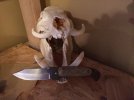In day to day tasks that involve cutting I can honestly say that I can pick an O1 knife from a 3V in around 5 minutes of use. Now to distinguish between 3V and M4 or 10V may take a little longer, but believe me it will show and you will notice a lack of cutting ability. I know this because I have done the comparisons numerous times. I have worked with almost all the steels mentioned in this thread and all that I work with work differently, cut differently, and dull differently. I have EDC'd knives I made from O1, 3V, M4, S90V, 10V, M390, ELMAX, 4V, CPM 20CV, D2, CPM D2, and PSF 27 to name most. I cut a lot of cardboard, paper, wood and plastic on a daily basis and differences show up very fast, especially in cardboard. In my use O1, ELMAX, and D2 dull the fastest. They would be the first separated into a pile. The PSF 27 and CPM D2 are very hard for me to tell apart in use, but they will last almost as long as the 3V. In multiple tests it could be difficult to pull the 3V knife from these other 2. The next group will include M4, 4V, 20CV, and M390. Finally you are left with S90V and 10V. I really do not see how anyone who has used these 2 steels can say they are not well rounded steels or that 52100 or AEB-L can stand next to them. I have used both 52100 and AEB-L and I would never make such a claim with a straight face. I have chopped 3/8" Poly-Carbonate sheet with S90V and experienced no edge damage. I have batoned both 10V and S90V through golf ball sized and larger cedar knots with no major edge damage. I have cut more cardboard with an S90V knife than any other and I usually run out of cardboard before the edge stops cutting. I have made several 10V hunting knives that were ground to .008" at the shoulders and used to process game. At a high hardness of 63 to 64 Rc there is plenty of edge stability to hold that fine edge. No, I would not recommend sticking the edge in a joint and prying sideways, but I would not do that with any steel. A few cuts around the joint and it separate on it's own. I do not just make knives, but I try to use them hard too. I try to push the edge geometry thin till it fails and then thicken it up till no failure occurs. These super steels might not like to bend and flex like the spring steels, but they were never intended to do so either. I just found out the other day that 10V was designed in the '70's to cut very large stacks of cardboard and paper. It is intended to be hard and stiff, but not brittle. I doubt that a spring steel that will bend and flex would make dead straight cuts or as many cuts as a 10V blade. 10V has an equal toughness to D2, it is just not found in larger blades because of the cost to produce.
Sorry about the ramble, I do not normally make posts this long. Yes the super steels are more expensive and you could get by with a piece of cheap Chinese surgical stainless. A new truck is also expensive when the old Ford Pinto or Chevrolet Chevette will get you to your destination. Advancing technology, improved performance, and bragging rights all play a part in our purchases. An old Colt 45 will shoot as good as a new Colt 45 but neither will be as accurate or perform as well as a Les Baer. O1 or 1095 will get the job done but will not perform as nice as a well made knife from CPM 10V.

